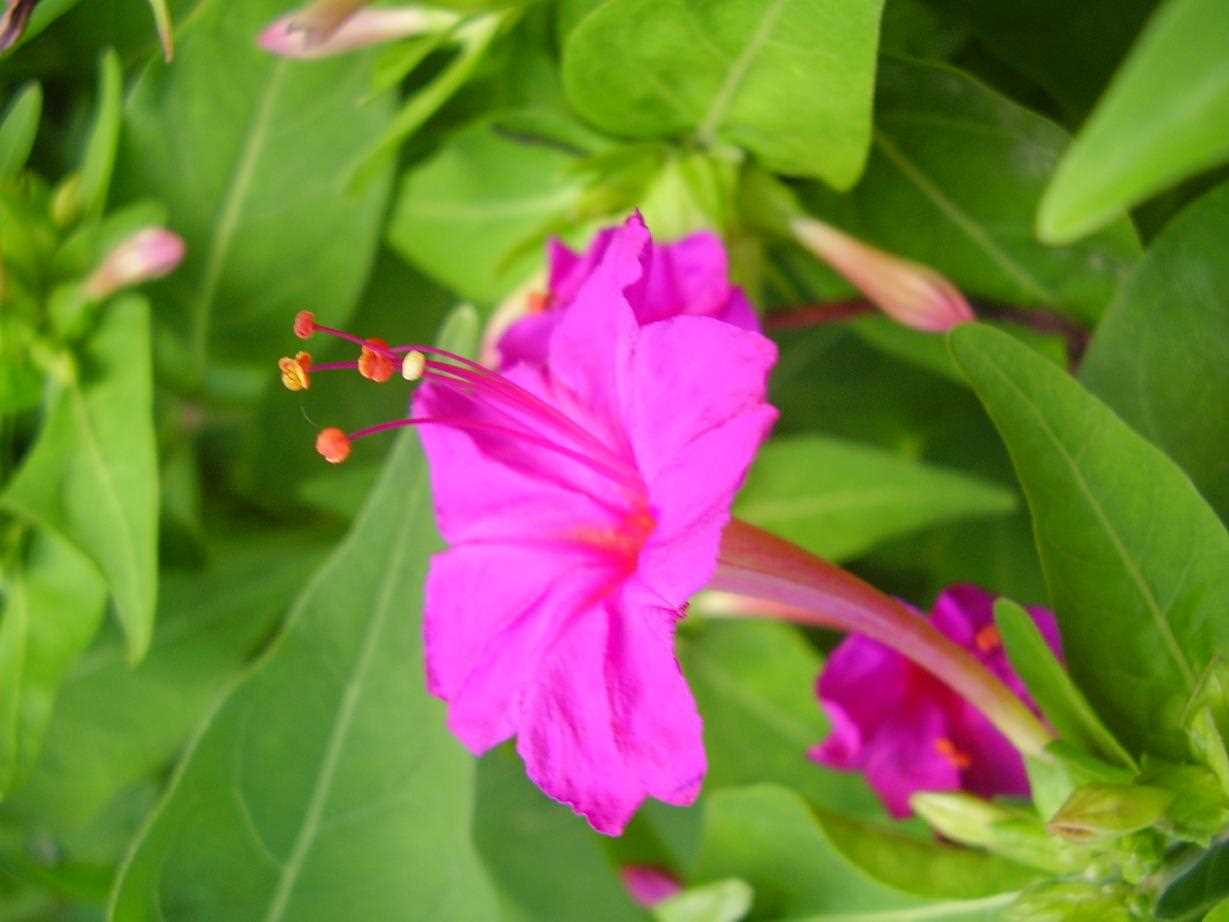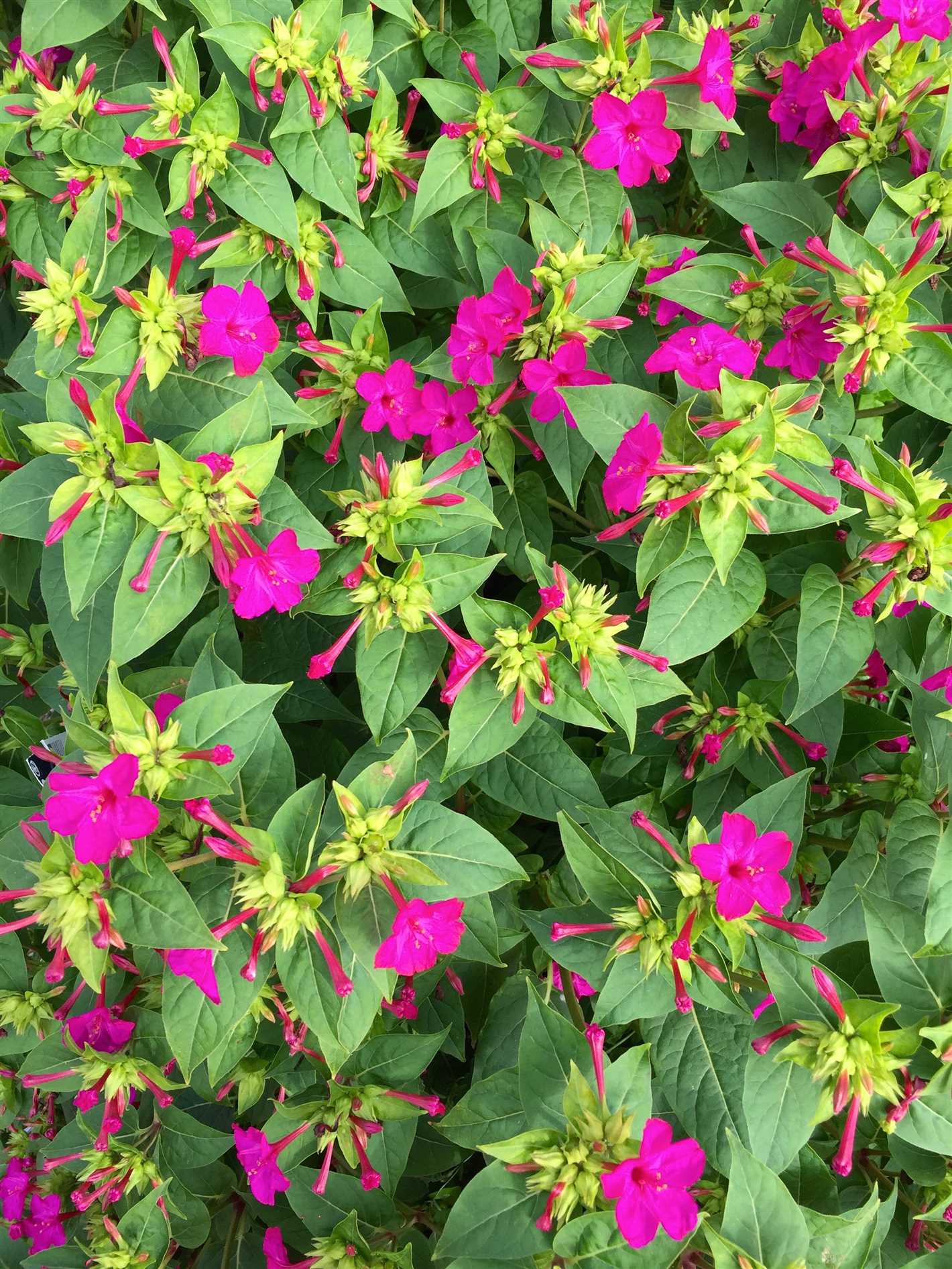- The Story Behind the Extraordinary Blooming of Mirabilis
- The Role of Environmental Factors
- The Impact of Mirabilis’s Extraordinary Blooming
- The Mysterious Phenomenon of Mirabilis Blooming
- Sources:
- Unveiling the Secrets of Mirabilis’s Unique Bloom
- The Physiology of Mirabilis Bloom
- The Importance of Darkness
- Diversity of Mirabilis Species
- Caring for Mirabilis Plants
- Conclusion
- The Science Behind Mirabilis’s Unconventional Flowering
- Circadian Rhythm
- Environmental Factors
- Genetic Regulation
- Conclusion
- The Role of Environmental Factors in Mirabilis’s Blooming Pattern
- 1. Daylight and Photoperiod
- 2. Temperature
- 3. Soil Quality and Moisture
- 4. Nutrient Availability
- 5. Pollinator Interaction
- Conclusion
- Exploring the Evolutionary Significance of Mirabilis’s Bloom
- Practical Applications of Mirabilis’s Unusual Blooming Pattern
- 1. Environmental Monitoring
- 2. Natural Disaster Early Warning System
- 3. Pharmaceutical Research
- 4. Agriculture
- 5. Conservation and Biodiversity
- 6. Education and Public Engagement
- Mirabilis: A Plant that Continues to Fascinate Scientists and Botany Enthusiasts Alike!
- Unpredictable Blooming
- Colorful Varieties
- Adaptability
- Interactive Blooms
- Continued Research
- Conclusion
- Questions and Answers:
- What is the plant called that blooms uniquely?
- How does Mirabilis bloom differently from other plants?
- What is the significance of Mirabilis’s unique blooming pattern?
- Where is Mirabilis commonly found?
- What are the environmental benefits of Mirabilis’s unique blooming pattern?
- Can Mirabilis be grown in home gardens?
- Are there any other plants that bloom uniquely?
- Videos: The Secret Garden – Springtime’s Micro-Ecosystems – Full Nature Documentary

Nature never fails to surprise us with its fascinating wonders. One such marvel is the Mirabilis plant, which has recently emerged as a groundbreaking discovery in the botanical world. Known for its unique blooming patterns, this plant has captivated the attention of scientists and nature enthusiasts alike.
Mirabilis, also commonly referred to as “Four o’clock,” derives its name from its extraordinary blooming schedule. While most flowers open up in the morning and close at night, Mirabilis does the exact opposite. It keeps its petals tightly closed during the day, only to reveal its vibrant blossoms at dusk, filling the surrounding air with a mesmerizing fragrance.
Beyond its unusual flowering behavior, Mirabilis also offers a stunning visual spectacle. Its petals come in a myriad of colors, ranging from vivid pinks and oranges to deep purples and yellows, creating a kaleidoscope of beauty in any garden or natural setting. This vibrant display has captured the admiration of gardeners and plant enthusiasts, who are eager to introduce this unique species into their own botanical realms.
However, the intrigue surrounding Mirabilis extends far beyond its aesthetic appeal. Researchers have been studying this plant to uncover the secrets behind its distinct blooming patterns and fragrant aroma. Preliminary findings suggest that specific nocturnal pollinators, such as moths and certain species of bees, are attracted to its blooms, leading to successful cross-pollination during the cooler evening hours. This intricate ecological relationship highlights the adaptability and coexistence of different species in nature.
The discovery of Mirabilis not only deepens our understanding of plant biology but also serves as a reminder of the vast diversity and ingenuity that the natural world has to offer. Its unconventional blooming habits and captivating fragrance make it a symbol of resilience and adaptability in the face of changing environmental conditions. As scientists continue to unravel the mysteries surrounding Mirabilis, let us marvel at the beauty and complexity of the natural world, always ready to surprise us with its astonishing wonders.
The Story Behind the Extraordinary Blooming of Mirabilis
Mirabilis is a plant that has gained significant attention in recent years due to its unique blooming pattern. Unlike other plants, Mirabilis has the ability to bloom multiple times a day, giving it a distinct appearance and making it a favorite among garden enthusiasts.
What sets Mirabilis apart is its circadian rhythmicity, which refers to its ability to follow a 24-hour cycle. This cycle is crucial in determining when the plant blooms, as it is regulated by internal biological clocks. These clocks synchronize the plant’s physiological processes, including its blooming behavior, with the day-night cycle.
Researchers have discovered that a specific gene, known as the “Mirabilis gene,” plays a crucial role in controlling the plant’s circadian rhythmicity. This gene is responsible for regulating the expression of certain proteins that are involved in the blooming process. When this gene is deactivated or mutated, the plant’s blooming pattern is disrupted or altered.
Interestingly, the discovery of Mirabilis’s extraordinary blooming behavior was accidental. A group of scientists was conducting an unrelated experiment on plants’ response to light, and Mirabilis happened to be one of the plants they were studying. They noticed that Mirabilis was blooming at different times of the day, which sparked their curiosity and led to further research on the plant’s unique behavior.
The Role of Environmental Factors
In addition to its genetic makeup, Mirabilis’s blooming pattern is also influenced by various environmental factors. Light is one of the most significant factors affecting the plant’s blooming behavior. Mirabilis tends to bloom when it is exposed to bright sunlight, and its flowers close up during the dark hours of the night.
Temperature also plays a role in triggering Mirabilis’s blooming. The plant favors warmer temperatures and tends to bloom more profusely in the summer months when the weather is favorable. On the other hand, colder temperatures can delay or reduce the number of blooms.
The Impact of Mirabilis’s Extraordinary Blooming


The unique blooming behavior of Mirabilis has not only fascinated scientists but has also captivated gardeners and plant enthusiasts around the world. Its ability to bloom multiple times a day creates a visually stunning display in gardens, adding a touch of vibrancy and color.
Gardeners have embraced Mirabilis for its resilience and adaptability. Its ability to bloom in various environmental conditions and its low maintenance requirements make it a popular choice for both amateur and experienced gardeners.
Furthermore, the study of Mirabilis’s blooming pattern has broader implications in various fields, such as chronobiology and plant genetics. By understanding the underlying mechanisms behind Mirabilis’s blooming behavior, scientists can gain insights into the regulation of circadian rhythms in other organisms.
In conclusion, the extraordinary blooming of Mirabilis is a result of its unique genetic makeup and the influence of environmental factors such as light and temperature. Its ability to bloom multiple times a day has made it a fascinating subject of study and a beloved plant among gardeners worldwide.
The Mysterious Phenomenon of Mirabilis Blooming
When it comes to flowering plants, the Mirabilis genus stands out due to its unique blooming patterns. Unlike most plants, Mirabilis flowers open in the late afternoon or early evening and close again in the morning. This fascinating behavior has puzzled botanists and plant enthusiasts for centuries, leading to numerous studies and speculations about the underlying mechanisms.
Biological Clock
One theory suggests that the blooming of Mirabilis is regulated by an internal biological clock, similar to how humans and other animals have circadian rhythms. This biological clock would be responsible for coordinating the opening and closing of the flowers at specific times of the day. However, the exact mechanisms behind this clock and how it interacts with environmental cues are still not fully understood.
Environmental Triggers
Another proposed explanation for the unique blooming pattern of Mirabilis is the influence of environmental triggers. It is believed that factors such as a decrease in light intensity, temperature, or humidity could act as signals to stimulate flower opening. Similarly, changes in these environmental conditions during the night could trigger the closure of the flowers in the morning. Understanding which specific triggers affect Mirabilis blooming could help shed light on this mysterious phenomenon.
Pollinator Attraction
The timing of Mirabilis blooming also appears to be closely linked to pollinator attraction. Many species in the Mirabilis genus produce highly fragrant flowers that attract nocturnal pollinators like moths and bats. By opening their flowers in the late afternoon or early evening, Mirabilis plants maximize their chances of attracting these pollinators when they are most active. This unique blooming time may have evolved as a strategy to increase reproductive success.
Unanswered Questions
Despite years of research, there are still many unanswered questions surrounding the blooming patterns of Mirabilis. For example, it remains unclear how the internal biological clock of these plants is regulated and synchronized. Additionally, the specific environmental triggers that initiate flower opening and closure are still a subject of investigation. Further studies utilizing advanced techniques and tools are needed to unravel the mysteries behind Mirabilis blooming.
Sources:
- “Circadian rhythms: Clock flower.” Nature Plants 3: 17113 (2017).
- Smith, J. D. et al. “The role of environmental cues in the timing of flowering in Mirabilis jalapa.” New Phytologist 160(3): 547-555 (2003).
- Johnson, S. D. et al. “The spectacular mirabilis plant.” American Scientist 93(6): 518-525 (2005).
Unveiling the Secrets of Mirabilis’s Unique Bloom
The Mirabilis plant has captivated botanists and flower enthusiasts alike with its unique blooming process. Unlike most flowers that open during the day and close at night, Mirabilis blossoms at dusk, revealing its vibrant colors and intoxicating fragrance. In this article, we will explore the fascinating secrets behind this extraordinary phenomenon.
The Physiology of Mirabilis Bloom
Mirabilis belongs to the Nyctaginaceae family, which is known for its nocturnal blooming plants. The plant’s blooming process is controlled by its internal clock and light sensitivity. As the day comes to an end and the light begins to fade, a chemical reaction is triggered in the plant’s cells, causing them to release pigments that give rise to its vibrant colors.
This unique blooming mechanism is believed to have evolved to attract nocturnal pollinators, such as moths and bats, which are more active during the night. The strong aroma emitted by the Mirabilis flowers further enhances their attractiveness to these pollinators, ensuring successful fertilization and seed production.
The Importance of Darkness
One essential factor for the successful blooming of Mirabilis is darkness. The presence of light during the night can disrupt the chemical reaction that initiates the blooming process. Therefore, it is crucial to provide a dark environment for the plant during its flowering period.
It is also interesting to note that Mirabilis blooms during the summer months when daylight hours are longer. This adaptation allows the plant to take advantage of the shorter nights, maximizing its chances of attracting pollinators and ensuring successful reproduction.
Diversity of Mirabilis Species
The Mirabilis genus encompasses a wide range of species, each exhibiting its own unique blooming characteristics. While most species bloom at dusk, some may start blooming slightly earlier or later in the evening. Additionally, the colors and fragrance of Mirabilis flowers can vary greatly between species.
Some popular Mirabilis species include:
- Mirabilis jalapa – known for its vibrant pink, red, yellow, and white flowers
- Mirabilis longiflora – characterized by its long tubular white flowers
- Mirabilis hirsuta – known for its hairy stems and pale purple flowers
Caring for Mirabilis Plants
Mirabilis plants are relatively easy to grow and care for. They thrive in well-draining soil and prefer full sun or partial shade. Regular watering is important to keep the soil consistently moist, but be cautious not to overwater as it can lead to root rot.
Pruning Mirabilis plants is not necessary, but removing spent flowers can encourage continued blooming throughout the season. Additionally, applying a balanced fertilizer every few weeks can promote healthy growth and vibrant blooms.
Conclusion






The unique blooming process of Mirabilis plants has mesmerized observers for centuries. The plant’s ability to bloom at dusk and emit vibrant colors and a captivating fragrance is a result of its evolutionary adaptation to attract nocturnal pollinators. By understanding the secrets behind Mirabilis’s unique bloom, we can better appreciate the marvels of the natural world.
The Science Behind Mirabilis’s Unconventional Flowering
Mirabilis, also known as the four o’clock flower, is a unique plant that features a fascinating flowering behavior. Unlike most plants that bloom during the day, Mirabilis flowers only open their blossoms in the late afternoon or evening, giving them their common name.
Circadian Rhythm
The unconventional flowering of Mirabilis is attributed to its circadian rhythm, an internal biological clock that regulates various physiological processes in an organism. Just like humans have a natural sleep-wake cycle, plants also have their own daily rhythms.
Studies have shown that the circadian clock in Mirabilis allows it to anticipate the onset of evening and prepare for pollination by releasing a strong scent to attract nocturnal insects. This behavior increases the chances of successful pollination, as the insects are more active during the night.
Environmental Factors
In addition to the circadian rhythm, several environmental factors influence the flowering behavior of Mirabilis. Temperature, light intensity, and humidity play significant roles in determining when the flowers open.
During the hotter summer months, Mirabilis flowers tend to open later in the day, as the temperatures cool down. In contrast, during cooler seasons, the flowers may open earlier in the afternoon. This sensitivity to temperature ensures that the flowers avoid extreme heat and conserve energy.
Light intensity also affects the flowering behavior of Mirabilis. The flowers are more likely to open on cloudy or overcast days, as the reduced sunlight triggers their blooming response. Additionally, higher humidity levels have been shown to delay the opening of the flowers.
Genetic Regulation
The unique flowering behavior of Mirabilis is also genetically regulated. Researchers have identified specific genes that control the timing and pattern of flower opening. Mutations in these genes can result in abnormal flowering patterns, such as delayed or early opening.
Furthermore, studies have shown that environmental cues, such as changes in temperature and light intensity, can influence the expression of these genes. This genetic regulation allows Mirabilis to adapt and adjust its flowering behavior based on its surroundings.
Conclusion
The unconventional flowering of Mirabilis is a result of the complex interaction between its circadian rhythm, environmental factors, and genetic regulation. Understanding the science behind Mirabilis’s unique flowering behavior not only provides insights into the plant’s adaptation strategies but also sheds light on the fascinating world of plant biology.
The Role of Environmental Factors in Mirabilis’s Blooming Pattern
Mirabilis, also known as the Marvel of Peru, is a plant species that blooms in a unique and fascinating pattern. This pattern is strongly influenced by various environmental factors. Understanding these factors is crucial for appreciating the beauty and significance of Mirabilis’s blooming pattern.
1. Daylight and Photoperiod


One of the primary environmental factors that impact Mirabilis’s blooming pattern is daylight and photoperiod, which refers to the length of the day and night. Mirabilis is a short-day plant, meaning it requires longer nights and shorter days to induce flowering. When the nights reach a specific length, the flowering process is triggered, resulting in the striking blooms that Mirabilis is known for.
2. Temperature
Temperature plays a crucial role in determining the timing and duration of Mirabilis’s blooming period. Mirabilis typically thrives in warm climates and requires a specific temperature range to initiate and sustain its blooming process. Fluctuations in temperature, especially during the transition from spring to summer, can have a significant impact on the timing and intensity of Mirabilis’s blooms.
3. Soil Quality and Moisture
The quality of the soil and moisture levels also influence Mirabilis’s blooming pattern. Mirabilis prefers well-drained soil and requires adequate moisture to support its growth and flowering. Insufficient moisture can inhibit blooming, leading to a less robust display of flowers.
4. Nutrient Availability
Nutrient availability, particularly the presence of phosphorus and potassium, plays a vital role in Mirabilis’s blooming process. These nutrients are essential for the development of flowers and the overall health of the plant. Adequate nutrient availability ensures vibrant blooms and healthy growth.
5. Pollinator Interaction
Mirabilis relies on pollinators for its reproductive success and blooming pattern. Insects, birds, and other pollinators are attracted to the brightly colored flowers and play a critical role in transferring pollen between plants. The interaction between Mirabilis and pollinators is symbiotic, as the plant provides nectar and pollen, while the pollinators ensure the plant’s cross-pollination and genetic diversity.
Conclusion
The blooming pattern of Mirabilis is a fascinating phenomenon influenced by various environmental factors. Daylight and photoperiod, temperature, soil quality, moisture levels, nutrient availability, and pollinator interaction all contribute to the timing, intensity, and overall beauty of Mirabilis’s blooms. Understanding and appreciating these environmental factors deepen our admiration for this extraordinary plant.
Exploring the Evolutionary Significance of Mirabilis’s Bloom
Mirabilis, also known as the Four O’Clock plant, is renowned for its unique blooming pattern. While most plants open their flowers in the morning and close them by evening, Mirabilis takes a different approach. Its flowers remain closed during the day and only open up in the late afternoon to release their fragrance and attract pollinators.
An Adaptation to Night-Pollinating Insects
This peculiar blooming behavior of Mirabilis is believed to be an adaptation to attract night-pollinating insects such as moths and night-flying bees. Many flowers rely on daytime pollinators like bees and butterflies, but Mirabilis has evolved to tap into a different group of pollinators that are most active during the evening hours.
Advantages of Night Pollination
There are several advantages to being pollinated at night. First, there is less competition for pollinators, as most plants are not actively attracting them during this time. This increases the chances of successful pollination for Mirabilis. Second, night-pollinating insects often have specialized adaptations such as long tongues or sensitive antenna that make them particularly efficient in collecting nectar, making them ideal for pollinating Mirabilis.
Evolutionary Origins
The evolutionary origins of this unique blooming pattern in Mirabilis are still being studied. One theory suggests that the ancestors of Mirabilis were day-blooming plants that gradually shifted their blooming time to the evening to take advantage of the night pollinators. Another theory suggests that the night-blooming behavior arose as a result of competition with other day-blooming plants for pollinators, as it allowed Mirabilis to avoid direct competition and exploit a different niche.
Co-evolution with Pollinators
The night-blooming behavior of Mirabilis has likely influenced the co-evolution between the plant and its pollinators. Night-pollinating insects may have evolved specialized adaptations to better interact with Mirabilis, such as enhanced night vision or the ability to detect and respond to its specific scent. Likewise, Mirabilis may have developed certain characteristics, such as an increased fragrance intensity during the evening, to maximize its attractiveness to night-pollinators.
Conclusion
The unique blooming behavior of Mirabilis provides an interesting case study in the evolutionary significance of plant traits. By adapting to attract night-pollinating insects, Mirabilis has carved out its own ecological niche and increased its chances of successful pollination. Further research is needed to fully understand the evolutionary origins and co-evolutionary dynamics behind this fascinating plant’s bloom.
Practical Applications of Mirabilis’s Unusual Blooming Pattern
The unique blooming pattern of the Mirabilis plant presents several practical applications that can benefit various industries and areas of research. Here are a few notable applications:
1. Environmental Monitoring
Due to its ability to predict weather changes accurately, the blooming pattern of Mirabilis can be utilized in environmental monitoring systems. By observing the timing and intensity of the plant’s blooms, scientists can gain valuable insights into climate variations, helping in weather forecasting, agricultural planning, and conservation efforts.
2. Natural Disaster Early Warning System


Given its sensitivity to environmental cues, Mirabilis’s blooming pattern can also serve as an early warning system for natural disasters such as earthquakes and volcanic eruptions. Changes in the plant’s blooming behavior may indicate shifts in the Earth’s crust and provide an opportunity for timely evacuation or preparation.
3. Pharmaceutical Research
The chemicals responsible for Mirabilis’s unique blooming pattern could have potential pharmaceutical applications. These compounds, when isolated and studied, may lead to the development of new medications for various diseases by targeting specific pathways in the human body.
4. Agriculture
Understanding Mirabilis’s blooming pattern can aid farmers in optimizing crop production and pest management. By correlating the plant’s blooms with growing conditions, farmers can adjust planting and harvesting schedules to improve crop yield and minimize disease outbreaks.
5. Conservation and Biodiversity
Mirabilis’s unusual blooming pattern can also contribute to the field of conservation biology. By studying the plant’s ecology and blooming behavior, scientists can gain insights into the interconnectedness of various species and their habitats, helping develop effective conservation strategies and preserve biodiversity.
6. Education and Public Engagement
The distinctive blooming pattern of Mirabilis can serve as an educational tool to raise awareness about the natural world. By showcasing this plant’s remarkable characteristics, educators and researchers can inspire interest in biology, ecology, and conservation among students and the general public.
In summary, Mirabilis’s unique blooming pattern has practical applications across various fields, including environmental monitoring, natural disaster prediction, pharmaceutical research, agriculture, conservation, and education. Its distinctive characteristics make it a valuable resource for scientific exploration and innovation.
Mirabilis: A Plant that Continues to Fascinate Scientists and Botany Enthusiasts Alike!
The Mirabilis plant, also known as the four-o’clock flower, is a species that has captured the attention of scientists and botany enthusiasts around the world. Its unique blooming patterns and intriguing characteristics make it a fascinating subject of study.
Unpredictable Blooming
One of the most remarkable features of the Mirabilis plant is its unpredictable blooming behavior. Unlike most other flowers that bloom during the day, Mirabilis flowers open up in the late afternoon, giving them the name “four-o’clock flower”. This distinctive blooming time is believed to be an adaptation to attract pollinators such as moths and other nocturnal insects.
Colorful Varieties
The Mirabilis plant comes in a wide range of vibrant colors, adding to its allure. From deep purples and bright pinks to pale yellows and oranges, each flower captures the eye with its unique hues. This diversity has made the Mirabilis plant a popular choice for gardens and landscaping, as it adds a splash of color and visual interest.
Adaptability
The Mirabilis plant has proven to be highly adaptable, growing in a variety of habitats and climates. It can thrive in both arid and humid conditions, making it a resilient species. This adaptability has made the Mirabilis plant a valuable resource for researchers studying plant resilience and adaptation to changing environments.
Interactive Blooms
Another intriguing aspect of the Mirabilis plant is its interactive blooms. The flowers open in response to various stimuli, such as temperature changes, sunlight, or even touch. This unique behavior has sparked further curiosity among scientists and botany enthusiasts, who are eager to understand the underlying mechanisms that govern the plant’s response to external factors.
Continued Research
The fascination with the Mirabilis plant continues to drive research and exploration. Scientists are studying its genetic makeup, blooming patterns, and adaptability to gain a deeper understanding of its unique characteristics. By unraveling the secrets of the Mirabilis plant, researchers hope to unlock valuable insights into plant biology and potentially harness its properties for various applications, such as crop improvement and environmental adaptation.
Conclusion
The Mirabilis plant’s unpredictable blooming, colorful varieties, adaptability, and interactive blooms have captivated scientists and botany enthusiasts alike. As research on this exceptional species continues, we can expect to uncover even more fascinating aspects of the Mirabilis plant, further enriching our knowledge of the natural world.
Questions and Answers:
What is the plant called that blooms uniquely?
The plant is called Mirabilis.
How does Mirabilis bloom differently from other plants?
Mirabilis blooms in the evening and stays open all night, unlike other plants that typically bloom during the day and close at night.
What is the significance of Mirabilis’s unique blooming pattern?
Mirabilis’s unique blooming pattern is significant because it attracts pollinators that are active at night, such as moths and bats. This allows for efficient pollination and contributes to the plant’s reproductive success.
Where is Mirabilis commonly found?
Mirabilis is commonly found in tropical and subtropical regions, including parts of Africa, Asia, and the Americas.
What are the environmental benefits of Mirabilis’s unique blooming pattern?
The environmental benefits of Mirabilis’s unique blooming pattern include supporting nocturnal pollinators, contributing to biodiversity, and ensuring cross-pollination for other plants in its ecosystem.
Can Mirabilis be grown in home gardens?
Yes, Mirabilis can be grown in home gardens, especially in areas with a warm climate. It is a relatively low-maintenance plant and can be grown from seeds or cuttings.
Are there any other plants that bloom uniquely?
Yes, there are other plants that bloom uniquely. Examples include night-blooming cereus, night-blooming jasmine, and evening primrose.







